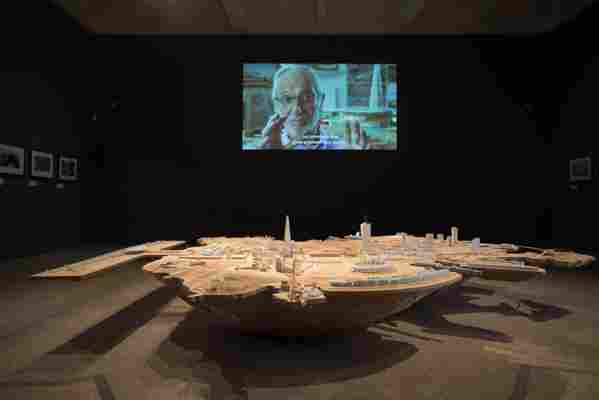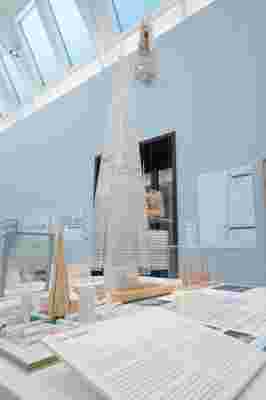A brave new world rises from a sprawling model island that seems to levitate off the spotless floor of the Royal Academy’s new architecture galleries. As part of the inaugural exhibition Renzo Piano: The Art of Making Buildings , curated by the RA’s Kate Goodwin, it collages over 100 projects conjured by one of the world's most prolific living architects. Unfurling at the island’s base is a model of Kansai International Airport, with its own airplanes. It feeds out into a starchitecture superhighway hosting both the hamster cagelike Pompidou—the building that catapulted Piano, then 34, to fame—alongside the New York Times building and the split-tip Shard. Nestled into the island’s undulating hills, valleys, and dramatic steppes are the less hyped projects: a much-jeered addition to a Corbusier-designed monastery in France rubs elbows with the donut-like San Nicola Stadium in Bari, Italy.
The variation of scale is striking: While a private residence in Colorado is the size of a peppercorn, a Piano-designed cruise ship moored on the northwest coast of the island outsizes all but a few buildings. In the background plays a short film by Thomas Riedelsheimer that presents Piano at his charming, articulate best self as he delivers an inspiring hot take on the role of architecture and the current crisis of urbanity. As abstract as this room may be, it is the most successful moment of Renzo Piano: The Art of Making Buildings —offering both a transparent, engaging presentation of his mind-bogglingly expansive practice, and the devout cult of personality that enables such a pervasive presence.

A wooded table shows a series of Renzo Piano's designs on it, with a video of the architect in the background.
For those familiar with Piano and his work, there are no new surprises or discoveries to be found within this exhibition. For visitors who are less in the know, the streamlined presentation of 16 of Piano’s most revered projects is more opaque, and risks misleading its audience. Each project gets its own pristine white table setup, with drawings, plans, models, letters, and scribbled Post-it notes ostensibly lending a sense of intimacy to the mammoth building or master plan. Unfortunately, the scale of the project is often left ambiguous or, in the case of Piano’s Centro Botín building, omitted entirely.
While it is stimulating to touch a pearlescent ceramic tile that comprises the Centro Botín, to get an up-close view of the Menil Collection’s magical light-emitting louvres, or to sense the crushing weight of one of the Pompidou’s gargantuan gerberettes (a hollow piece of steel) as it hovers over your head, there is no indication of how it feels to experience these buildings, no sense of concern over the awesome and at times overbearing impact of such structures as they bear down on the street. The curatorial hand feels literally overbearing at times, in the architectural bits that loom over every table like astronauts. Yet, it also fails to offer an overarching idea that bridges together all of his work, other than suggesting what’s obvious: Piano is an intelligent and daring thinker with an indelible influence upon the built world.

The Shard in London, significantly smaller in scale, on display at the Royal Academy in London.
As the first major survey of Piano’s work in London in nearly 30 years, The Art of Making Buildings feels like a missed opportunity for the discipline, and those headlining it, to disprove architecture’s hermetic and superficial tendencies. "Architecture is the art of making a place for people,” declares Piano in the exhibition’s short film, but in a move that echoes the architect’s capacity to valorize an idealized form of beauty over lived experience, the exhibition turns a blind eye to the concept of an architecture beyond the art of building.
As the old chestnut confirms, art is in the eye of the beholder. And as such, it would be prudent for visitors to tour the exhibition, which runs through January 20, 2019, and come to their own conclusion.
